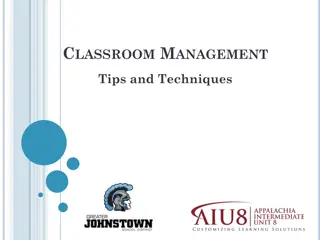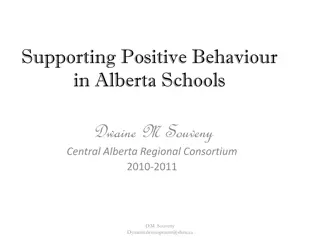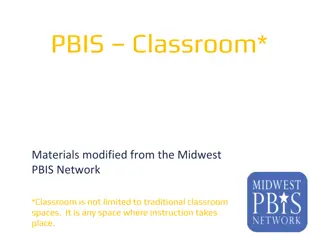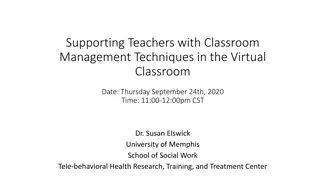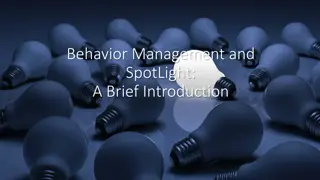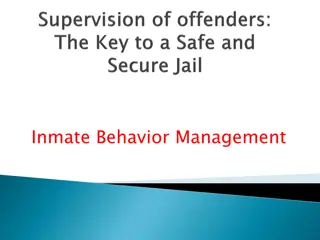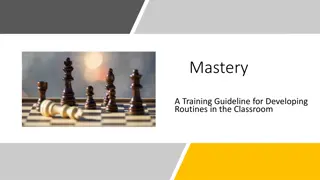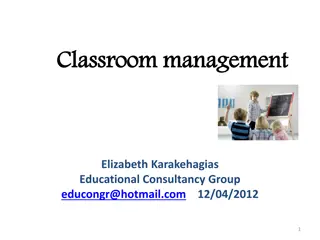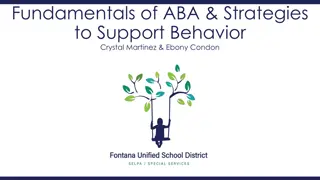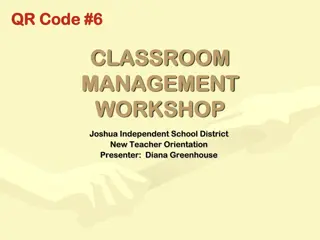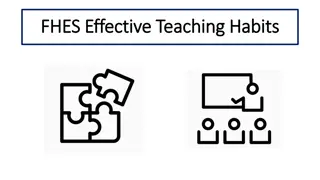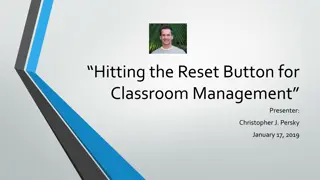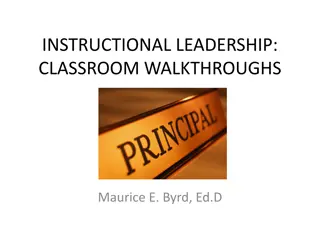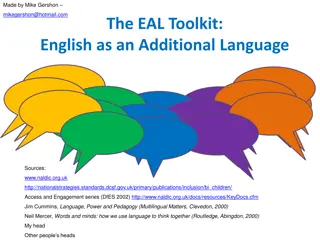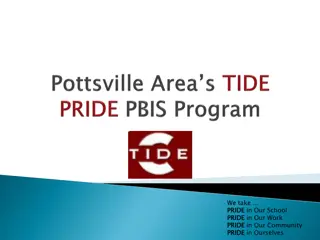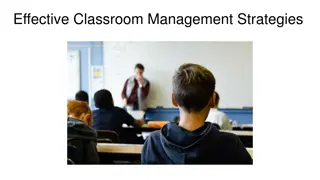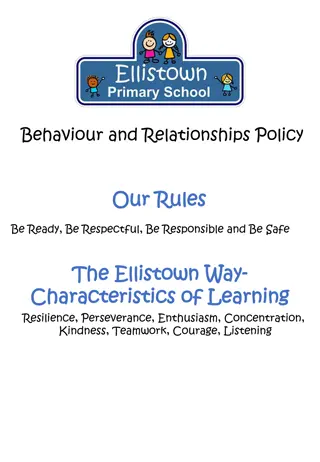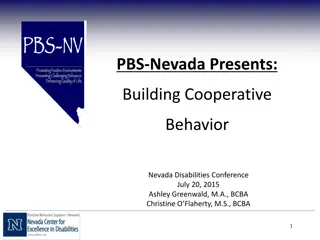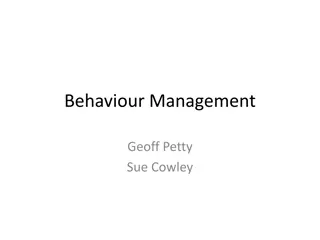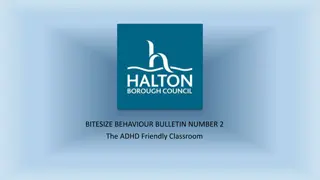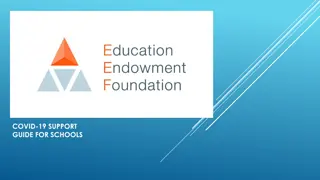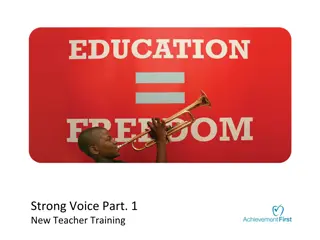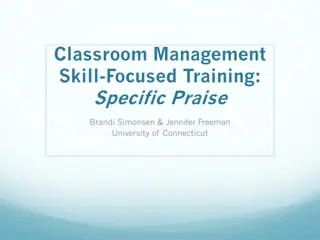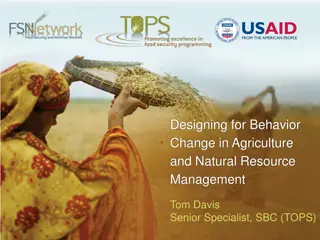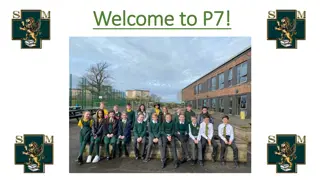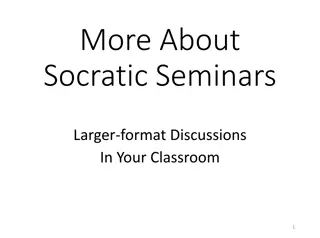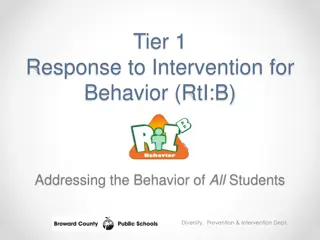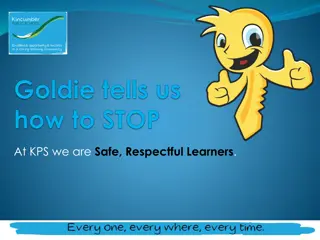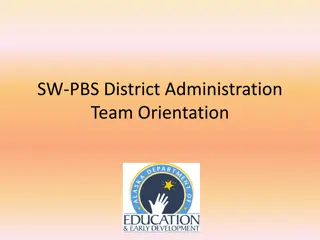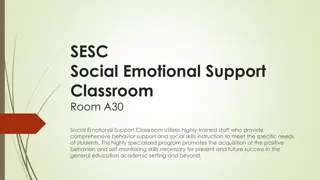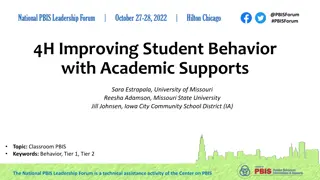Effective Strategies for Classroom Management and Positive Behavior Support
Explore concepts on classroom management, behavior communication, and teacher impact on student well-being. Learn about de-escalation techniques, crisis response, and the power of positive feedback in creating a conducive learning environment. Understand the crucial role of teachers in shaping student experiences and behaviors.
Download Presentation

Please find below an Image/Link to download the presentation.
The content on the website is provided AS IS for your information and personal use only. It may not be sold, licensed, or shared on other websites without obtaining consent from the author. Download presentation by click this link. If you encounter any issues during the download, it is possible that the publisher has removed the file from their server.
E N D
Presentation Transcript
Glasgow UK Council of the year 2015 Glasgow City Council Supporting Glasgow s Learners All Behaviour is Communication Probationer Teachers 2019
Outline of this mornings programme Classroom ethos and avoiding confrontation in the classroom. Impact on the teacher and the pupil. Classroom based corrective actions and how to avoid defensive teaching and reactive sanctions. Use of positive feedback and praise. The Brain and The Arousal Cycle and how to de-escalate a situation. How to spot when a pupil is moving into crisis, how to respond when the pupil is in crisis and what to do next. Debriefing and duty of care. What the teacher can expect from senior management if they are involved in an incident.
Ive come to a frightening conclusion that I am the decisive element in the classroom. It s my personal approach that creates the climate. It s my daily mood that makes the weather. As a teacher, I possess a tremendous power to make a child s life miserable or joyous. I can be a tool of torture or an instrument of inspiration. I can humiliate or heal. In all situations, it is my response that decides whether a crisis will be escalated or de-escalated and a child humanized or dehumanized. Haim G. Ginott
Positive Model of Behaviour Management Troubleshooting Dealing with problems Time Spent Management Managing behaviour with Classroom strategies Prevention Creating a positive learning environment High Quality Learning and Teaching Birkett (2005)
Negative Model of Behaviour Management Dealing with problems Troubleshooting Managing behaviour with Classroom strategies Time Spent Management Creating a positive Learning environment Prevention Birkett (2005)
All Behaviour is Communication Words we use 7% Body language 55% Tone of voice 38%
Why do children become distressed? Think about some reasons why children and young people become distressed, discuss with a partner.
Why do children become distressed? Fight, flight, freeze response threat (functional anger) Stress and coping Additional Support Needs Developmental stage Reinforcement? Link to internal working model of themselves as shameful Trauma / ACES Other?
Distressed versus Challenging Behaviour All Challenging Behaviour meets a need for the individual it is a solution, not a problem! ALWAYS ASK YOURSELF What need does this behaviour meet for the other person ? Will my intervention make things better or worse ? Am I in control of myself ?
Defining behaviour? What is the difference between challenging, distressed, aggressive or violent behaviour? Depends on personal experience Depends on the individual
Iceberg metaphor Behaviour Swearing, angry outbursts, running away Fears and anxiety Maladaptive stress response Poor communication skills Misinterpretation of events Overloaded by stimulation (ASD) Traumatic experiences (ACES) Possible reasons/ communicative functions
Video Clip- Negative and Positive Teacher responses
Confrontation Confrontation refers to a showdown between 2 or more parties It often starts as a trivial incident or comment which escalates into a protracted and heated exchange In a classroom it can lead to removal/ exclusion and disrupts learning and teaching
Think about a confrontation that you have witnessed or experienced and describe to the person next to you:- What started the confrontation? What was the outcome? How did you feel?
Feedback from Video Clip How did that make you feel? Who was right and who was wrong? How could this have been avoided? Who won?
Impact of confrontation in the classroom For the Adult Anger my authority has been challenged Fear who loses is weak, perceived by the audience Embarrassment having to seek help is an admission of failure Anxiety loss of rapport with pupil Blame something must be wrong with the pupil
Impact of confrontation For the Pupil Anger undermining my self worth Fear who loses is weak, perceived by the audience Embarrassment in front of peer group Anxiety- loss of rapport with teacher Blame the teacher is nuts, has it in for me Shamed
Think about this! In all your years of working with young people, has a pupil ever stopped in the middle of a confrontation and said I m sorry, you are right, I was wrong! The adult is the experienced person and it is the adult who has the status to be in control of the situation
Classroom based responses to off task behaviour Using Post It notes list 10 ways of responding to a pupil who is not working on task that does not involve moving the pupil out of the class or seeking help from another teacher. Think of a continuum of actions that you could use. You have 15 minutes
Possible Options The Look Physical presence with non verbal correction Proximity Praise or Behavioural Narration Whole Class feedback Use of pupil s name Verbal feedback / individual correction Request to speak to pupil at end of lesson to follow up issue Move pupil to another seat in the class Demerit / Points Removal / Traffic Light warning Referral to Principal Teacher / Year Head
The importance of planning responses in the classroom Allows for quick correction of low level behaviour Prevents rapid escalation Maintain teacher control without becoming defensive Reactive responses are more likely to get you into trouble Helps transitions between teachers
Problem Times Settling the class at start of a lesson Transitions Interruptions / Messages Dead Time Loss of equipment (pens, ruler, etc) Closing the lesson
Setting a lesson-PRINT Purpose Resources In/ Out of seat Noise level Time
Noise Level What level of noise is acceptable to you as the teacher during the activity? No Voice Partner Voice Group Voice Classroom Voice Playground Voice
Time How long do I want this activity to last, when will it finish and how do I tell the pupil that it is time to finish?
Positive Feedback When you are positive with pupils you create a positive learning environment where you will feel positive
How to give Effective Feedback No strategy is more important to a teacher s success in the classroom than the effective and consistent use of behavioural narration.
Behavioural Narration The teacher narrates the behaviour of students who are following instructions Teacher: Walk back to your seat, take out your book and get to work on Page 18 without talking! Ready, go! Teacher: Barbara is walking back to her seat. Karen has her book out and is working without talking! Andrew is back in his seat and has also taken is book out and is also working without talking! Gives opportunity to repeat your instructions again and again. Enables you to give positive feedback to students who are on task. Provides a model for the visual learner or pupil who has difficulty processing multiple instructions.
Steps for using behavioural narration 1. Give clear directions to pupils 2. Immediately look for at least 3 pupils who are correctly following the directions. 3.Say the pupil s names and narrate how they are following the directions.
Behavioural Narration vs Praise Totally different concepts Praise is judgemental, when you use it you make evaluative statements about the behaviour. Behavioural narration is non-judgemental. You are describing the behaviour you are observing. Behavioural narration helps students to be self-directed. It also helps prevent pupils from misbehaving as it reduces the amount of correction needed for inappropriate behaviour. Focus on those who are doing as you asked.
Correcting Non Disruptive Off Task Behaviours Many teachers ignore off task non disruptive behaviour hoping the pupil will magically get back on track. The Look Just giving a look that says I m aware of and disapprove of your behaviour Physical Proximity walk over and stand close to the pupil. Mentioning the pupil s name while teaching may redirect his attention back on task. Proximity Narration Narrate the appropriate behaviour of nearby pupils e.g. John and Fiona are both writing in the books! , pick 2 pupils on either side of the pupil not on task.
Correcting Disruptive Off Task Behaviours Most teachers are too quick to rely on the use of corrective feedback. They try to correct the behaviour of those pupils not doing as they were asked. Why do teachers tend to focus negatively on the behaviour of pupils who do not do what they want? CONCERN ABOUT LOSING CONTROL IN YOUR CLASSROOM
Problems with this approach By giving attention to pupils who don t listen to you, you are teaching them that the way to get your attention is to misbehave You create a negative learning environment when you constantly focus on what pupils are doing wrong by nagging and threatening them to get them to behave.
A more effective way 1. Give clear directions to your pupils I want you to sit down at your desk and start working without talking! 2. Use behavioural narration, focussing on pupils who are following directions. DO NOT focus on the ones who are not working. 3. If pupils are still off task use corrective feedback immediately John, the directions were to get to work at your desk without talking. You have the choice to get to work, or we will have to talk at the interval! 10 Second rule- You have only 10 seconds to correct the off task behaviour or disruption before other pupils pick up on it.
Guidelines for Giving Corrective Feedback Provide corrective feedback in a calm, clear manner (think about how you would correct a child who has made a reading error) Restate the directions calmly look at the pupil and firmly restate the directions Present corrective actions as a choice- Sean you have a choice- stop talking and start reading, or you will have to sit by yourself at the time-out table. It s your choice. Correct the behaviour every time- be consistent as you would if teaching any subject Plan the corrective item you will take do not act impulsively
Rules Whole School Rules and Class Rules should be the same, this will assist staff e.g. wearing baseball caps, bringing equipment, transitions Keep them simple and a maximum of 5 Ensure that they are applied consistently throughout the school
Activity In your group, write a maximum of 4 class rules that cover all aspects of classroom expectations. 5 minutes
Use your hands to imagine your brain Hand model courtesy of Dan Siegel
Now we look at what happens when When we get distressed we Flip Our Lid!
If we flip our lid and the upstairs brain - strategies and behaviours Aggression Safety through dominance Absence Safety through concealment I run! Appeasement Safety through manipulation the downstairs brain - instantaneous response Fight Remove the threat Flight Remove self! Freeze Infantilise to attract adult help Immobility, big eyes, smiles, perhaps incontinence SURVIVING not thriving
Putting the lid back on De-escalation Vagus nerve oxytocin, dopamine, etc. lowering blood pressure deeper breathing reduced muscle tension Escalation HPA (stress) axis adrenaline, cortisol, etc. rising blood pressure shallow breathing increased muscle tension The upstairs brain is back in action SAFETY The downstairs brain is in charge SURVIVAL
Use of touch Know the child well e.g. previous trauma Think about how you move in and out of their own space Part of wellbeing plan to support child Discussed with parents Never place yourself or the child at risk
Positive Model of Behaviour Management Troubleshooting Dealing with problems Time Spent Management Managing behaviour with Classroom strategies Prevention Creating a positive learning environment High Quality Learning and Teaching Birkett (2005)
Warning The vast majority of pupils are fully engaged in learning, they behave well in class and act responsibly Do not panic over the next section, you are likely never to need this knowledge in your teaching career but!
The Arousal Cycle Trigger Phase Escalation Phase Crisis Phase Recovery Phase Post Crisis Phase Learning Phase Crisis Additional Outbursts A R O U S A L Aggression Anger Anxiety Baseline Behaviour Exhaustion TIME
The Arousal Cycle Trigger Phase Escalation Phase Crisis Phase Recovery Phase Post Crisis Phase Learning Phase Crisis Additional Outbursts A R O U S A L Aggression Anger DANGER Anxiety PERCEIVED THREAT Baseline Behaviour Exhaustion TIME


